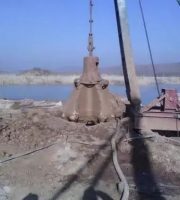1、 Summary of causes of hollowing and cracking of plastering surface 1
. 
Oily release agent is used for mold demoulding, which causes hollowing and cracking of plastering surface due to too smooth concrete surface and poor adhesion
. 
2
. 
The masonry assembly and structure are unreasonable, and masonry settlement leads to hollowing / cracking of plastering surface
. 
3
. 
The junction of different materials is not treated with hanging net, or the hanging net method is unreasonable, leading to air crack
. 
4
. 
The grooved surface of multi pipe line is not blocked or the blocking method is unreasonable, which leads to the spalling surface
. 
5
. 
Before plastering, the concrete and autoclaved masonry are not sprayed or the adhesion is poor
. 
6
. 
The plastering mortar is mixed randomly without effective guarantee of mortar strength
. 
7
. 
Mortar king and other additives are added to the mortar to reduce the mortar strength
. 
8
.
If the thickness of one-time plastering is too thick (more than 12mm) or the interval time of layered plastering process is insufficient (less than 12 hours), the mortar on the plastering surface slips, and the plastering layer is prone to appear horizontal sagging cracks, which makes the plastering layer on the wall appear empty
.
9
.
The finished plastering surface was not cured in time and there was no effective water retaining measures
.
10
.
After plastering, the pipeline is slotted and installed, and the plugging method is unreasonable
.
II
.
Analysis on the causes of anti bulging and cracking of plastering and improvement measures: the use of engine oil or solvent based release agent on the surface of wood mold causes the plastering surface to be too smooth or residual oil residue on the surface, and the poor adhesion leads to the plastering surface to crack
.
Improvement method: the water-based release agent should be used for the non fair faced concrete demoulding, and the time of demoulding should be controlled, so as to ensure the forming quality of concrete, ensure the adhesion of concrete, and reduce the risk of air crack in the later stage
.
Cause analysis: the inclined roof brick is not dense, the inclined roof angle is too large, the inclined roof of the long wall is constructed in the same direction, and it is easy to crack in the later stage
.
Improvement method: the inclined top brick should be built compactly, the angle should be 45-60 degrees, when the wall is long, the inverted eight character two-way masonry should be used, and the middle part should be placed with finished triangular block
.
Cause analysis: the joint of structural column and masonry is not set with horse teeth, which reduces the seismic and crack resistance of structural column
.
Improvement method: the horse tooth tenon of structural column shall be retreated first and then advanced, and the tenon length shall not be less than 6cm
.
The tie bar of structural column shall be retained every 50cm, and the length of tie bar entering the masonry shall be 500mm
.
Cause analysis: the short buttress wall near the door is built with cement brick, without biting, and the short buttress concrete is not planted with reinforcement, so the crack resistance is poor
.
Improvement method: it is difficult to build the short buttress masonry wall near the door, and it is easy to crack and deform in the later stage
.
In order to improve the stability of the short buttress, the cast-in-place structure can be used, and the reinforcement is planted every 30cm
.
Cause analysis: the joints of different materials were not treated with hanging net; the galvanized net was directly pasted with cement mortar, the galvanized net arched and the crack resistance strength was insufficient
.
Improvement method: concrete and fired brick are fixed with heat preservation nail, sand aerated with cement nail, and the galvanized net is flat without arching
.
Cause analysis: the slot of the front pipe is not blocked, the pipe is not fixed with the masonry, and the crack resistance is poor
.
Improvement method: fixed clamp or cement nail should be used to fix the pipeline after the pipeline installation
.
Before painting, the pipelines shall be slotted and sealed in time
.
The slotting of single and double pipes can be sealed with anti crack mortar
.
The three line pipes and above shall be sealed with fine aggregate concrete and micro expansion agent
.
After sealing, the galvanized steel wire mesh shall be used for reinforcement
.
Cause analysis: the slotting depth of the line pipe is insufficient, the line pipe is beyond the masonry surface after being fixed, and the plastering surface is a weak part, which is easy to cause cracks in this part
.
Improvement method: strictly control the slotting depth of line pipe, DN + 10mm ≤ slot depth ≤ DN + 20mm, slot width DN + 20mm ≤ slot width ≤ DN + 60mm
.
To avoid the damage of the wall caused by too deep slotting, it is difficult to close the wall if the slotting is too small
.
Cause analysis: the concrete shotcreting fullness is insufficient, the strength is poor, there are many shotcreting spalling, reduce the adhesion, easy to lead to plastering cracks
.
Improvement method: the concrete shotcreting fullness is insufficient, the strength is poor, there are many shotcreting spalling, reduce the adhesion, easy to lead to plastering cracks
.
Cause analysis: the plastering mortar is mixed randomly, there is no fixed feeding ratio, the sand content of mortar is too high, and the mixing is uneven
.
Improvement measures: make sure the mix proportion of mortar, set up effective measurement facilities, strictly control the feeding ratio, set up a group of mortar test blocks in each batch, send them to the third party for compressive testing, conduct large flour brushing construction, and record the feeding ratio of mortar every two hours
.
Cause analysis: the use of mortar king and other state orders prohibit mortar additives, reduce the strength of cement mortar, easy to cause plastering surface crack, sand
.
Improvement measures: strictly according to the laboratory proportion sheet to determine the mortar feeding, ratio, prohibit the use of mortar king and other state orders to prohibit the use of additives, to ensure the strength of cement mortar
.
Cause analysis: the plastering survived at one time, and the cement mortar dropped after a single plastering, resulting in cracks on the plastering surface
.
Improvement method: strictly control the thickness and interval of one time plastering, the thickness of single layer plastering should be controlled within 1.2cm, and the interval of plastering should be more than 12 hours
.
Considering the effectiveness of management, it is suggested that the bottom coarse ash and surface layer should be painted every other day
.
Cause analysis: maintenance and water retaining measures after plastering, hot and dry weather is easy to cause plastering surface crack
.
Improvement method: in hot and dry weather, the plastering surface should be watered every four hours for curing, and the duration should be controlled for one week
.
Celite water retaining agent can also be used, and the curing time can be set to once every two days
.
Cause analysis: the groove after plastering surface should be sealed in an unreasonable way, which is easy to produce hollowing and cracking
.
Improvement method: before plastering, the pipeline shall be completely installed, and the grooving after plastering surface shall be avoided as far as possible, resulting in cracks on plastering surface; if it is necessary to groove after plastering, the grooving depth and plugging process shall be strictly controlled
.
The grooving depth after plastering surface shall be controlled at more than 2cm from the pipeline to plastering surface
.
The plugging mortar shall be added with micro expansion agent
.
The plugging shall be completed in two times, and the interval time shall be more than 12 hours
.
Source: construction workers.
.


